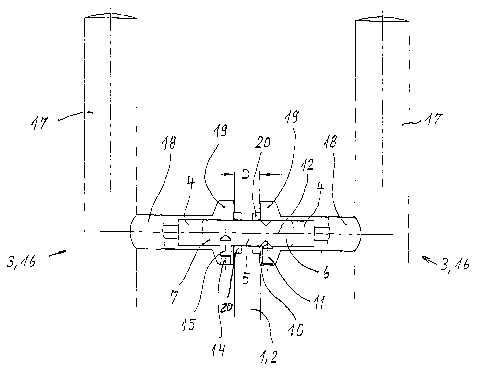Une partie des informations de ce site Web a été fournie par des sources externes. Le gouvernement du Canada n'assume aucune responsabilité concernant la précision, l'actualité ou la fiabilité des informations fournies par les sources externes. Les utilisateurs qui désirent employer cette information devraient consulter directement la source des informations. Le contenu fourni par les sources externes n'est pas assujetti aux exigences sur les langues officielles, la protection des renseignements personnels et l'accessibilité.
L'apparition de différences dans le texte et l'image des Revendications et de l'Abrégé dépend du moment auquel le document est publié. Les textes des Revendications et de l'Abrégé sont affichés :
| (12) Demande de brevet: | (11) CA 2512888 |
|---|---|
| (54) Titre français: | DISPOSITIF POUR LA FIXATION DE POIGNEES DE PORTE |
| (54) Titre anglais: | DEVICE FOR FASTENING DOOR HANDLES |
| Statut: | Réputée abandonnée et au-delà du délai pour le rétablissement - en attente de la réponse à l’avis de communication rejetée |
| (51) Classification internationale des brevets (CIB): |
|
|---|---|
| (72) Inventeurs : |
|
| (73) Titulaires : |
|
| (71) Demandeurs : |
|
| (74) Agent: | NORTON ROSE FULBRIGHT CANADA LLP/S.E.N.C.R.L., S.R.L. |
| (74) Co-agent: | |
| (45) Délivré: | |
| (86) Date de dépôt PCT: | 2004-08-17 |
| (87) Mise à la disponibilité du public: | 2005-03-31 |
| Licence disponible: | S.O. |
| Cédé au domaine public: | S.O. |
| (25) Langue des documents déposés: | Anglais |
| Traité de coopération en matière de brevets (PCT): | Oui |
|---|---|
| (86) Numéro de la demande PCT: | PCT/EP2004/009187 |
| (87) Numéro de publication internationale PCT: | WO 2005028786 |
| (85) Entrée nationale: | 2005-07-07 |
| (30) Données de priorité de la demande: | ||||||
|---|---|---|---|---|---|---|
|
L'invention concerne un dispositif de fixation de poignées de porte (3), procédé selon lequel un trou borgne (4) est ménagé sur chaque poignée de porte (3) pour recevoir un goujon (8) pouvant être bloqué avec chaque poignée de porte. L'invention est fondée sur le fait que les poignées de porte (3) opposées d'une ferrure sont identiques et que sur une des deux parties d'extrémité (7) du goujon (8) sont formés, pour l'insertion d'une vis (15), plusieurs alésages (13) qui sont décalés tant dans le sens circonférentiel que par rapport à l'axe longitudinal (12) du goujon (8).
The invention relates to a device for fastening door handles (3). A pocket
bore (4) is provided on each door handle (3) for accommodating a pin (8) that
can be locked by means of each door handle (3). The invention is characterized
in that the opposite door handles (3) of an armature are embodied in an
identical manner while several centering bores (13) into which a threaded
screw (15) is to engage are disposed on one of the two final sections (7) of
the pin (8), said centering bores (13) being offset both in the
circumferential direction and relative to the longitudinal axis (12) of the
pin (8).
Note : Les revendications sont présentées dans la langue officielle dans laquelle elles ont été soumises.
Note : Les descriptions sont présentées dans la langue officielle dans laquelle elles ont été soumises.

2024-08-01 : Dans le cadre de la transition vers les Brevets de nouvelle génération (BNG), la base de données sur les brevets canadiens (BDBC) contient désormais un Historique d'événement plus détaillé, qui reproduit le Journal des événements de notre nouvelle solution interne.
Veuillez noter que les événements débutant par « Inactive : » se réfèrent à des événements qui ne sont plus utilisés dans notre nouvelle solution interne.
Pour une meilleure compréhension de l'état de la demande ou brevet qui figure sur cette page, la rubrique Mise en garde , et les descriptions de Brevet , Historique d'événement , Taxes périodiques et Historique des paiements devraient être consultées.
| Description | Date |
|---|---|
| Demande non rétablie avant l'échéance | 2007-08-17 |
| Le délai pour l'annulation est expiré | 2007-08-17 |
| Réputée abandonnée - omission de répondre à un avis sur les taxes pour le maintien en état | 2006-08-17 |
| Inactive : CIB de MCD | 2006-03-12 |
| Inactive : Page couverture publiée | 2005-09-27 |
| Lettre envoyée | 2005-09-23 |
| Exigences relatives à une correction du demandeur - jugée conforme | 2005-09-23 |
| Inactive : Notice - Entrée phase nat. - Pas de RE | 2005-09-23 |
| Demande reçue - PCT | 2005-09-01 |
| Exigences pour l'entrée dans la phase nationale - jugée conforme | 2005-07-07 |
| Demande publiée (accessible au public) | 2005-03-31 |
| Date d'abandonnement | Raison | Date de rétablissement |
|---|---|---|
| 2006-08-17 |
| Type de taxes | Anniversaire | Échéance | Date payée |
|---|---|---|---|
| Taxe nationale de base - générale | 2005-07-07 | ||
| Enregistrement d'un document | 2005-07-07 |
Les titulaires actuels et antérieures au dossier sont affichés en ordre alphabétique.
| Titulaires actuels au dossier |
|---|
| DORMA GMBH + CO. KG |
| Titulaires antérieures au dossier |
|---|
| RALF KREYENBORG |